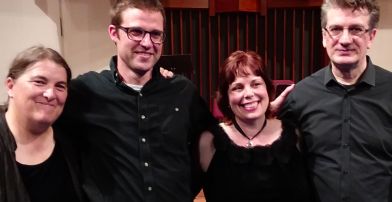|
Symphony
MYSTICAL PLANETS AND LIVELY GERSHWIN ORTIZ AT FINAL SRS CONCERT
by Peter Lert
Sunday, May 4, 2025
Symphony
VSO'S CONCERT MUSIC OF TIME, MUSIC OF PLACE
by Peter Lert
Sunday, April 27, 2025
Choral and Vocal
VOCAL ELEGANCE AND FIRE AT THE 222'S RECITAL APRIL 26
by Pamela Hicks Gailey
Saturday, April 26, 2025
CANTIAMO SONOMA SINGS AN INSPIRED GOOD FRIDAY MOZART REQUIEM CONCERT
by Pamela Hicks Gailey
Friday, April 18, 2025
DRAMATIC SHOSTAKOVICH SYMPHONY CLOSES PHILHARMONIC'S 25TH SEASON
by Terry McNeill
Sunday, April 13, 2025
LARGE COLLEGE OF MARIN AUDIENCE GREETS STOPHER ARTISTRY
by Terry McNeill
Saturday, April 5, 2025
Chamber
FRISSON DELIVERS SHIVERS OF DELIGHT
by Abby Wasserman
Sunday, March 30, 2025
OLD AND MOSTLY NEW IN SRS MARCH CONCERT IN WEILL
by Peter Lert
Saturday, March 22, 2025
Symphony
TWO FORMIDABLE SYMPHONIES AND PURPLE MOUNTAINS AT SRS CONCERT
by Peter Lert
Sunday, February 23, 2025
Chamber
THE PARKER CAPTURES DEMANDING ADES QUARTET AT RAC SEBASTOPOL CONCERT
by Peter Lert
Saturday, February 15, 2025
|
 |
 (l to r) Carol Adee, Kevin Gordon, Wendy Loder, Daniel Canosa |
ECHO OPENS NEW SEASON WITH PROVOCATIVE PROGRAMMING
by Abby Wasserman
Sunday, September 22, 2019
ECHO Chamber Orchestra’s season opening concert Sept. 22 featured an ambitious program of four works, ranging from 1815 to the very present. Performed in the graceful high-vaulted First Presbyterian Church of San Anselmo, the concert engaged rapt attention of the 70 attending. Conducted by Daniel Canosa, ECHO presents a single performance at each program and draws between 25 and 52 musicians from around the Bay Area, and the ensemble’s musical scope is far-reaching.
The evening began with one movement of Louise Ferranc’s Nonet in E-flat major, Op. 38. Scored for violin, viola, clarinet, oboe, French horn, bassoon, double bass, cello and flute, it was performed leaderless, and musical cohesion depended on the musicians listening closely to one another. Ferranc (1804-1875) was a celebrated pianist and the first femme to have a professorship at the Paris Conservatory, where she taught for 30 years. Her Nonet’s adagio-allegro movement is a sprightly introduction to the full work, transparent and charming, with solo parts for each of the nine instruments. The group could have used more rehearsal time and there was some struggling here and there with tempi, and pitch problems from the violinist. The ensemble sections were well done, and the winds and brass in particular accomplished their solos with precision and panache.
From France the musical tide flowed to Russia and Rachmaninoff’s exquisite Vocalise, Op. 34, No. 14, for Soprano and Orchestra. It was originally composed for soprano or tenor and piano. Soprano Wendy Loder, who is also the orchestra’s concertmaster, was the soloist. Ms. Loder’s wide vibrato (the word “warble” comes to mind) soared from note to note on a single vowel ah. The piece has the hypnotic quality of Debussy’s Sirènes and the depth of Prokofiev’s “The Field of the Dead” from his cantata Alexander Nevsky. Mr. Canosa held the orchestra in check so that they never overwhelmed the soloist, but elegantly supported her. Each vocalist in this wordless song must choose the story to tell, and to some, it is a narrative of grief, hope and resolution. Ms. Loder chose to accentuate the sustained, lilting musical line. The audience held their applause for a brief moment, but the performance could have been even better greeted with meditative silence.
Prior to the Vocalise performance, Mr. Canosa and double bassist Kevin Gordon provided verbal notes from the stage for the world premiere of their collaborative composition, City Suite. It was inspired by their individual impressions of four cities and their collective impressions of a fifth. The form of each, they said, relates to the dances in suites by Bach. There were unfortunately no program notes but the duo’s explanation was comprehensive. For his part of the process, Mr. Canosa selected Amsterdam and Buenos Aires, the city of his birth. Mr. Gordon chose San Francisco and New York, and the two collaborated on Paris.
Each movement except for “Buenos Aires” had a subtitle of a baroque dance found in Bach: “Amsterdam” was in prelude form; “San Francisco” a bourée; “Paris” an allemande morphing into the tango rhythms of “Buenos Aires,” and “New York” a gigue. But in no other way does City Suite remind one of the Baroque period. It positively cascades with sensual and visceral impressions. “Amsterdam,” the first and most dissonant of the movements, evokes city bustle, church bells, the changing blue light of high latitude summer skies, and rhythmic, pulsing percussive bursts. “San Francisco” blended hippie, funk and fog with high tech. “Paris” incorporated a medieval chant calling on the god of love, which Ms. Loder rose to sing in Latin. The movement then swept attacca (without pause) into the tango rhythms of “Buenos Aires.” The last movement, Mr. Gordon’s “New York,” brought the Suite to an exciting climax with jazzy flair.
Flowers were presented to the conductor, soloist and Mr. Gordon, and then, laying his flowers on the floor and with true ECHO informality, Mr. Canosa simply turned to the audience and said, “Now we’ll do the Schubert.”
The Schubert was his Third Symphony in D major, composed in the summer of 1815, a few months after Schubert’s 18th birthday. Like the rest of his first six symphonies, it wasn’t published during his lifetime. The first movement, adagio maestoso—allegro con brio, began with drama but moved quickly into ebullient sound. The second movement (menuetto: vivace) evoked Mozart, and the presto vivace third was played very Rossini-like, in an almost operatic style. Despite those associations, the performance was all Schubert, full of bold experimentation and lovely melodies. The orchestra performed with skill and gusto, and the audience responded enthusiastically.
The concert was followed by a reception and art show in the Church’s social hall.
|

